DSAEK big bubble a simple, efficient technique
The method entails creating a peripheral iridotomy and leaving a large air bubble in the eye to promote graft adherence without the risk of pupillary block.
Click Here to Manage Email Alerts
 Thomas John |
Endothelial transplantation has evolved over a relatively short period to replace conventional, full-thickness transplantation, namely penetrating keratoplasty for endothelial decompensation. Of the various current surgical techniques for endothelial transplantation, Descemet’s stripping automated endothelial keratoplasty appears to be the most favored by corneal surgeons. However, one continued challenge has been the attachment of the donor corneal disk without postoperative detachment.
Air has advantages and disadvantages in ophthalmic surgery, depending on the amount and location of injection. In this column, Drs. Kubal and Davis describe their surgical technique of using a big air bubble safely in performing DSAEK to consistently attach the donor corneal disk to the inner surface of the recipient cornea.
Thomas John, MD
OSN Surgical Maneuvers Editor
We have developed a simple and effective DSAEK technique, which we call the DSAEK big bubble technique, that allows for increased surgical efficiency. The technique requires the creation of a peripheral iridotomy so that a large air bubble can be left in the eye at the end of the case to promote graft adherence and avoid the risk of pupillary block.
Surgical technique
Although topical, retrobulbar or general anesthesia can be used in this technique, we generally prefer a retrobulbar block. At the start of the case, the cornea is measured with calipers to determine the appropriate size of the donor corneal button, which usually measures between 7 and 9 mm in diameter. With the surgeon sitting superiorly, a 2 o’clock paracentesis and a 10 o’clock 3-mm limbal wound are then made as they are for standard cataract surgery. The anterior chamber is filled with a miotic agent followed by viscoelastic.
An inferior peripheral iridotomy is then created by grasping the peripheral iris tissue at the 6 o’clock position with Utrata forceps placed through the main incision and retinal microscissors thorough the paracentesis (Figure 1). The inked trephine is then placed over the center of the cornea to mark the placement of the DSAEK graft and serve as a guide for the diameter of Descemet’s membrane to be stripped. Stripping is then performed with a John Dexatome spatula (ASICO) by scoring Descemet’s membrane in a circular fashion. This is done just inside the ink mark from the trephine using gentle upward pressure. Two circular passes are usually adequate to completely score Descemet’s membrane. The John Dexatome then allows the scored Descemet’s membrane to be stripped centrally for 360°. Descemet’s membrane and viscoelastic are then removed with the irrigation/aspiration handpiece.
 Figure 1. A peripheral iridotomy is created inferiorly using Utrata forceps through the main incision and retinal microscissors through the paracentesis. |
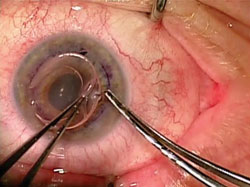 Figure 2. The donor tissue is brought to the surgical field with the endothelial side up. Toothed forceps are used to separate the endothelial half of the tissue from the epithelial half. |
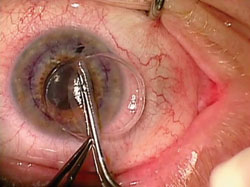 Figure 3. The donor endothelial button is folded with a 60/40 taco overfold. Using a pair of Goosey forceps (Moria), the tissue is grasped along the folded edge. |
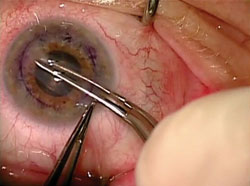 Figure 4. The donor button is inserted into the anterior chamber. During removal of the forceps, another instrument is placed at the wound to prevent extrusion of the tissue. |
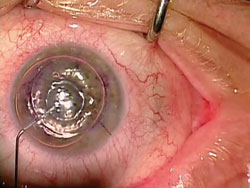 Figure 5. Air is injected into the anterior chamber underneath the graft using a 30-gauge cannula. Care is taken to inject the air slowly to allow for the tissue to unfold with the proper orientation. |
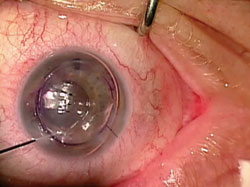 Figure 6. With a reverse Sinskey hook, the tissue is positioned centrally. Additional air is placed into the anterior chamber to bring the IOP to approximately 30 mm Hg. Images: Davis EA, Kubal
A |
We generally use eye bank precut tissue. This tissue is of excellent quality, and its use decreases surgical time. Once trephination of the donor cornea is performed, the tissue is brought to the surgical field with the endothelial side up (Figure 2). With two pairs of toothed forceps, the endothelial half is separated and folded over to ensure a 60/40 taco overfold. This overfold allows for proper orientation of the tissue once it its placed in the anterior chamber and eliminates the need for marking the stromal side of the donor button. The tissue is then grasped with Goosey forceps (Moria) along the folded edge (Figure 3) and inserted into the anterior chamber (Figure 4). During removal of the Goosey forceps, another pair of forceps is placed at the wound to prevent the tissue from coming out of the anterior chamber. The wound is then closed with a single 10-0 nylon suture.
Air is then injected into the anterior chamber through a 30-gauge cannula, making sure to place the air in between the two leaflets of the folded donor lenticule so that it unfolds with the proper orientation (Figure 5). Air should be injected slowly as rapid injection may result in the tissue flipping over. The donor button is then positioned using a reverse Sinskey hook to grasp the tissue and move it centrally. Additional air is injected into the anterior chamber to pressurize the globe to approximately 30 mm Hg and tamponade the graft against the host cornea (Figure 6). Using a LASIK roller or other similar instrument, interface fluid is then massaged out by stroking the corneal surface from center to periphery in all four quadrants. Subconjunctival injections of an antibiotic and steroid are then administered at the end of the case.
The patient is given 500 mg of oral acetazolamide postoperatively, once the evening of surgery and once the following morning.
References:
- Allen MB, Lieu P, Mootha VV, et al. Risk factors for intraocular pressure elevation after descemet stripping automated endothelial keratoplasty. Eye Contact Lens. 2010;36(4):223-7.
- Ghaznawi N, Chen ES. Descemet’s stripping automated endothelial keratoplasty: innovations in surgical technique. Curr Opin Ophthalmol. 2010;21(4):283-7.
- Shih CY, Ritterband DC, Rubino S, et al. Visually significant and nonsignificant complications arising from Descemet stripping automated endothelial keratoplasty. Am J Ophthalmol. 2009;148(6):837-43.
- Thomas John, MD, is a clinical associate professor at Loyola University at Chicago and is in private practice in Tinley Park and Oak Lawn, Ill. He can be reached at 708-429-2223; fax: 708-429-2226; e-mail: tjcornea@gmail.com.
- Elizabeth A. Davis, MD, FACS, can be reached at Minnesota Eye Consultants, 9801 Dupont Ave. South, Bloomington, MN 55431; 952-567-6067; fax: 952-885-9942; e-mail: eadavis@mneye.com.
- Aarup Kubal, MD, can be reached at e-mail: aarup.kubal@gmail.com.

